February 15, 2008
Air Date: February 15, 2008
FULL SHOW
SEGMENTS
Renewed Effort on Renewable Energy
/ Jeff YoungView the page for this story
Congress is about to renew its effort to boost renewable energy. Similar proposals fell just short of final passage twice in recent months. Living on Earth's Jeff Young tells us the wind and solar industries are hoping the third time’s the charm. (06:00)
Toxic Info Withheld
View the page for this story
The Centers for Disease Control is postponing the release of a report detailing areas of environmental concern and human health problems in the Great Lakes region. Living on Earth host Steve Curwood talks with Christopher De Rosa, who was director of the Division of Toxicology and Environmental Medicine at the CDC and oversaw the report. De Rosa was demoted when his work on toxins in the Great Lakes, and on formaldehyde in FEMA trailers for Hurricane Katrina survivors, was publicized. (06:00)
The Future of Human Health
View the page for this story
In the second of a two-part series, host Steve Curwood sits down with famed inventor and futurist Ray Kurzweil to discuss human health, and look into the future when humans will become enhanced by machines. Kurzweil says that nanobots will soon go inside our bodies to repair damaged areas and add years to our lives. (09:00)
Drug Questions of Today
View the page for this story
Recent studies cast doubt on long accepted treatments to lower cholesterol and treat diabetes. Given the criteria the FDA uses to approve most drugs, it’s no surprise, says Dr.Jerry Avorn, author of “Powerful Medicines, the Benefits, Costs and Risks of Prescription Drugs.” (05:00)
Project BudBurst
View the page for this story
Volunteers can now help scientists track climate change by going online and entering information about when they see local plants bloom. Host Steve Curwood speaks with Dr. Kay Havens, director of Plant Science and Conservation at the Chicago Botanic Garden, about the project. (03:50)
Bad News from the Blubber
/ Bruce GellermanView the page for this story
Living on Earth’s Bruce Gellerman talks with Dr. Roger Payne and Captain Iain Kerr on board the research vessel Odyssey in Gloucester, Massachusetts. The pair recently completed a five and a half year journey around the world to collect samples of whale blubber to analyze for pollution - and they’re shocked by the results. (15:35)
This week's EarthEar selection
listen /
download
Yes, whales snore too!
Show Credits and Funders
Show Transcript
HOST: Steve Curwood
GUESTS: Dr. Jerry Avorn, Dr. Christopher De Rosa, Dr. Kay Havens, Ray Kurzweil,
REPORTERS: Jeff Young, Bruce Gellerman
[THEME]
CURWOOD: From Public Radio International - this is Living on Earth.
[THEME]
CURWOOD: I’m Steve Curwood. Congressional democrats try - yet again - to rev up renewable energy, to fight climate change boost jobs, and the economy.
SWISHER: There are millions of dollars at stake, many thousands of jobs. Our estimate is that if the credit is not extended, between wind industry and the solar industry we see 116,000 jobs in U.S. at stake.
CURWOOD: Also, sampling whale blubber.
KERR: You understand your place in the wild world when you study whales. You know we all think it’s all about humanity and yet you get out on the ocean with some of these whales, eyes the size of a grapefruit, little wrinkles, and they’re looking at you saying, “You’re an intelligent species, look at my lifestyle.”
CURWOOD: Lifestyles of the huge and cetaceous, in the polluted oceans. Those stories and more - this week on Living on Earth. Stick around!
[MUSIC: Boards Of Canada “Zoetrope” from “In A Beautiful Place Out In The Country” (Warp Records 2000)]
ANNOUNCER: Support for Living on Earth comes from the National Science Foundation and Stonyfield Farm.
Renewed Effort on Renewable Energy

Double duty: solar panel and wind turbines in Hull, UK. (Photo: Flickr/Steve Roe)
CURWOOD: From the Jennifer and Ted Stanley Studios in Somerville, Massachusetts - this is Living on Earth. I’m Steve Curwood.
Congress is about to renew efforts to boost renewable energy. Democratic leaders say they want to repeal subsidies to the oil and gas industry and put that money instead into incentives for clean energy like wind and solar power.
Living on Earth’s Washington Correspondent Jeff Young is plugged into the energy debate and he’s here to tell us what’s at stake. Hi there Jeff!
YOUNG: Hi Steve.
CURWOOD: Jeff, this sounds familiar. The Democrats tried this before, right?
YOUNG: That’s right. The House of Representatives approved an energy bill last year that would take away oil subsidies and support renewable energy. But that fell one vote short in the senate. Then Democratic leaders tried to put incentives for wind and solar in the economic stimulus package. And again, that measure also failed in the Senate, by just one vote. Well now Democrats are hoping the third time’s a charm.
RANGELL: Well yes we think its very important it should have been passed and we just don’t just give up on things because the senate’s not cooperative.
YOUNG: That’s New York Democrat Charles Rangell. He chairs the powerful house Ways and Means Committee, which has just produced a 17 billion dollar bill to extend tax credits crucial to the solar and wind industries. Randy Swisher directs the American Wind Energy Association. He says those credits are set to expire at the end of the year.
SWISHER: This is way too familiar a story unfortunately.
YOUNG: The phenomenal growth in wind power is largely due to the production tax credit, which pays two cents on every kilowatt-hour produced by windmills. Swisher says there is generally strong support for the tax credit. So why has it twice failed to win final passage?

Double duty: solar panel and wind turbines in Hull, UK. (Photo: Flickr/Steve Roe)
YOUNG: And that could be the case again. Rangell and House democrats want to pay for the renewable energy tax credits by repealing oil industry subsidies. The powerful petroleum lobby and oil patch lawmakers will fight that, as they have before by arguing that the end result will be an increase in gas prices for consumers. Swisher’s worried that wind power’s growth could stall if the tax credits fail again.
SWISHER: There are millions of dollars at stake, many thousands of jobs. Our estimate is that if the credit is not extended, between the wind industry and the solar industry we see 116,000 jobs in the U.S. at stake. There are already companies that are reevaluating whether to make investments in new manufacturing capability. Those kinds of decisions are being made right now and with every month that goes by, the impact will grow.
YOUNG: Swisher and others are betting that the flipside of that equation will be a strong selling point to Congress. Growth in renewable energy jobs has been one of the few bright spots in an otherwise dim economic season. Rhone Resch is president of the Solar Energy Industries Association.
RESCH: This is a chance for us right now to extend these tax credits and really create a robust industry and put people back to work and many of the people who will work in the solar industry are the same people who are being laid off by the building industry – roofers, electricians, plumbers carpenters. We can give them high quality jobs in the solar industry right now.
YOUNG: The pending bill would extend solar tax credits for up to eight years. Businesses could claim up to 30 percent of the cost of installing solar systems. Homeowners could get up to four thousand dollars in tax credits for going solar. Resch knows the politics will be tough but he has a, well, a sunny outlook.
RESCH: This is an election year and so what I think is different about this vote at this time is that there are many senators who are up for election who represent states that have large renewable energy industries developing and it’s time for those senators to support this legislation and reverse their “no” vote to a “yes” vote for renewable energy in the U.S.
YOUNG: And Steve, a few key votes to watch on this: Republican John Sununu who has a lot of solar and wind equipment makers in New Hampshire but voted against these tax credits last time. And the only democrat in the senate to vote against this was Louisiana’s Mary Landrieu, who’s a big supporter of her home state’s oil industry. Both of them face the voters in reelection this year.
CURWOOD: And Jeff what about the presidential candidates in the Senate?
YOUNG: Well both Hillary Clinton and Barack Obama have voted for renewable energy. Senator John McCain could have made the difference when renewable energy was up for a vote as part of that recently passed economic stimulus package but he missed the vote. And of course it failed by exactly one vote.
CURWOOD: And the current occupants of the White House, they’re both former oil men. Jeff, I’m gonna make a wild guess here and say that they’re against taking away oil industry subsidies.
YOUNG: It’s like you’re clairvoyant. Good guess. In fact, when a similar package came up late last year the White house threatened a veto and they’re making similar noises this time.
CURWOOD: So it is the last year of the Bush Administration, any indications of what the President wants to get done on his way out the door regarding energy?
YOUNG: Well the President just sent his final budget to congress and it generally favors fossil fuels with subsidies for coal and there’s one curious item on oil. The President wants to completely fill up the nation’s strategic petroleum preserve, and that’s already meeting some resistance.
CURWOOD: The strategic reserve, now that’s the large underground supply of oil that’s kept in case of an emergency of some kind. What’s the objection to filling it up?
YOUNG: Well, it’s already nearly full, and of course oil is at near record high prices. So if you were to top off that great big tank so to speak, with oil at 90 or so dollars a barrel, well it’s really gonna cost a lot—something like 500 million dollars. So some key democrats in Congress are already floating a bill to stop that, they say, “Well this might be good for the oil industry to buy their oil when it’s at record high prices, but it’s not a very good thing for tax-payers, or the budget.”
CURWOOD: Thanks, Jeff. Jeff Young is Living on Earth’s Washington correspondent.
Related links:
- American Wind Energy Association
- Solar Energy Industries Association
- Energy Tomorrow
Toxic Info Withheld
CURWOOD: The US scientific community more and more is speaking out about what they see as improper governmental interference in conducting and disseminating research.
The latest call for scientific integrity comes from the American Association for the Advancement of Science at its annual meeting in Boston. One case in point is the work of toxicologist Christopher De Rosa at the Centers for Disease Control.
First he came under fire for disclosing that FEMA trailers provided to people displaced by Katrina contain formaldehyde, which is suspected to cause cancer. And now the CDC is refusing to release a report that Dr. De Rosa supervised about cancer rates and other health effects and pollution in contaminated areas around the Great Lakes. He was recently demoted and stripped of supervisory authority.
Dr. De Rosa, welcome to Living on Earth.
DE ROSA: Thank you.
CURWOOD: Dr. De Rosa, tell me about this Great Lakes study, what kind of substances were people being exposed to in the region?
DE ROSA: Well you might imagine it’s a range of the usual suspects. Things like dioxin, mercury, alkyl lead, hexachlorobenzene, DDT, polycyclic aromatic hydrocarbons, polychlorinated biphenyls or PCBs, and the list would go on.
CURWOOD: Let me ask you about the health problems that you found in these 26 areas of concern. In particular, what did you see in terms of cancer, infant mortality, premature birth, that sort of thing.
DE ROSA: Well we did see some elevated rates of breast cancer. There were elevated rates in 17 out of 26 of the areas of concern. Colon cancer, there we see 16 areas of concern with elevated rates, and in the case of lung cancer, 12. There were also some perinatal effects that we observed. For example, low birth weights in six of the 21 counties, infant death in 21 of the 26, also deficits in fertility. There were deficits in immune function, which is significant because some of the chemicals, such as PCBs do affect the immune system and suppress the immune system.
CURWOOD: Your agency is declining to release this report, why?
DE ROSA: The actual reasons for not doing so have not necessarily been shared with me formally but I do know that among the terms that have been used are that it may be “alarming” and that it required further review.
CURWOOD: Dr. De Rosa, we called the CDC and reached a spokesperson there, Glen Nowak, and asked him this very question as to why the report wasn’t being released and he had this to say about the quality of the report.
NOWAK: There were two or three major concerns. One was that the environmental data that was presented in the report was more recent than the health indicator data and so if you’re trying to look for associations that should be reversed. Another concern was that the health data that was presented in the report didn’t map very well with respect with the areas of concern that were looked at on environmental issues.
CURWOOD: So the criticism of this by your own agency is that this report unfairly correlates areas having high levels of toxic substances and human health problems, but is that fair to say? Do you try to make that correlation in this report?
DE ROSA: No. Not at all. In fact repeatedly it’s stated that that is not the intended purpose of the report, it’s simply to give communities ready access to the most recently available information that they’ve already paid for as tax-payers.
CURWOOD: On the one hand we have this report that you worked so hard on, that the government does not want to release. On the other hand we have a report that you put together about the effects of formaldehyde coming out of the furnishings inside the FEMA trailers that caused so much consternation when this material got out into the public, and we see your demotion inside the department. It sure looks political to me.
DE ROSA: Well you know, the word political to me, I think it’s in Webster, it’s refers to as the wise use of power. The point being that I was responsible for oversight of a division of 60-70 highly trained technical individuals that I’d been working with since arriving here at the agency, and I now have no such responsibility.
CURWOOD: You supervise yourself and the space between your desk and the wastebasket.
DE ROSA: Well, it really extends over to the door. No, I’m just being facetious. I do not have any supervisory responsibilities.
CURWOOD: How do you feel about the government suppressing this report that could be used for neighborhoods, communities to take steps to protect the health of their citizens?
DE ROSA: The only thing I can share with you there Steve, is that what I have stated, perhaps to my own detriment, is that I am concerned that there is important health information that is not being shared with the public and that this might have implications for their health.
CURWOOD: Dr. Christopher De Rosa is the Assistant Director for Toxicology and Risk Analysis at the Agency for Toxic Substances and Disease Registry at the Centers for Disease Control. Thank you so much sir.
DE ROSA: My pleasure.
CURWOOD: The CDC says Dr. De Rosa’s study is still under review. For more information and to see parts of an unofficial draft of the report obtained by the Center for Public Integrity, go to our website, L-O-E dot org.
Related links:
- Click here to see excerpts of the CDC report, and read an article about Christopher De Rosa's work
- About Dr. Christopher De Rosa
[MUSIC: Mocean Worker: “Salted Fatback” from Enter The Mowo (Hyena Records 2004)]
The Future of Human Health

Ray Kurzweil (Photo: Dennis Foley)
CURWOOD: It’s Living on Earth, I’m Steve Curwood.
[MUSIC: Kurzweil Internet Recordings]
CURWOOD: A few weeks ago we featured music from the Kurzweil synthesizer... and a conversation with its creator- Ray Kurzweil. He's a renowned inventor – he’s created robots and reading machines for the blind as well as the synthesizer, and now he’s using his knowledge and skills to imagine the future. He explains them in his latest book, "The Singularity Is Near: When Humans Transcend Biology."
Part of that transcendence, he believes will be a dramatic improvement in human health. As he explained when we visited him in his Kurzweil Technologies office outside of Boston, Massachusetts that’s because he’s faced his own health problems... a personal battle with diabetes that set him thinking.
KURZWEIL: I do have an interest, an acute interest, in health. I developed type two diabetes about twenty years ago. Tried the conventional approach and actually made things worse. So I developed my own approach using nutritional supplements, and nutrition and lifestyle- overcame my diabetes. I’ve had no indication of diabetes for the last twenty years. But it did actually, more than just dealing with this one specific health challenge, gave me the idea that we can really overcome our health challenges with the right ideas. And it really put me on this path of really addressing health challenges. So, I encountered another health challenge, which was middle age...
CURWOOD: That’s a challenge familiar to many of us, but Ray Kurzweil thinks he's beaten it - with a regimen of dozens of vitamins and nutraceuticals. Now, he may look like he's in his late 50's, but he says according to blood tests and lab results his body acts like it’s 40. He's collaborated with physician Terry Grossman on a book to chart the way to extending healthy life. It’s called “Fantastic Voyage- Live long enough to Live Forever.”

Ray Kurzweil and Steve Curwood (Photo: Dennis Foley)
CURWOOD: You say this with great confidence - It’s not we’re likely to - you say this as if it’s done already.
KURZWEIL: Well, we actually have the means of re-programming the basic principles of our biology- we can turn genes off that’s a new thing. Now health and medicine is transforming from a pre-information era where we really didn’t have information models of how biology worked. It was really hit or miss- oh here’s something that lowers blood pressure, but we don’t know why it works and there was no theory of operation and invariably these drugs have side-effects. The new paradigm is a really understated disease process and aging process set of information processes and reprogram them... Not that each of these techniques is guaranteed to work but it’s a much more powerful methodology and the really important point - comes back to what I said earlier- that now that health and biology and medicine are becoming information technologies, they are subject to what I call the “Law of accelerating returns” which is this doubling of the power of these technologies every year. And you could see it in the genome project- the amount of genetic material we’ve sequenced has doubled every year. Very smoothly for the last 15 years. The price has come down by half every year. So, things that were not feasible before are becoming quite affordable. And 10-15 years from now it’s going to be a very different world in our ability to program these information processes…
[MUSIC: [MUSIC: Kurzweil Internet Recordings]
CURWOOD: So, information and understanding about how the body functions, and the ability to manipulate those processes. Ray Kurzweil says that’s the second bridge - the key to better health in the medium term. Then comes bridge three.
KURZWEIL: Bridge Three is nanotechnology. The quintessential application, I used to say "killer app" but people didn’t like that in the context of health- is nanobots. Basically, blood-cell-sized devices, that can go inside the bloodstream and actually perform therapeutic functions inside. By the 2020’s this will be quite routine to send millions or billions of these nanobots, as they’re sometimes referred to- to keep us healthy from inside and also go inside our brain and expand our mental functioning.
CURWOOD: So what kind of lifespan do you expect when these kick online?
KURZWEIL: Ultimately, there’s really no reason why they can’t reverse any kind of damage that occurs. I mean how long does a house last? Well, it depends on whether or not you take care of the house. If you have a policy that you're aggressive- anything that goes wrong you immediately fix it, occasionally you upgrade systems like the HVAC, the house can go on indefinitely. In fact we do have structures that have lasted thousands of years. Now why doesn’t that apply to the house we live in: our bodies? Well, one difference is we understand how a house works. We know how to fix all the things that go wrong with a house, because we created houses so we understand their principles of operation. We don’t yet have all that knowledge about our bodies. We don’t have a full understanding of the biology, so we can’t fix everything that goes wrong, but that’s my thesis- that within about 20 years we will have fully reverse-engineered biology. We will have the means through biotechnolgy and nanotechnolgy to fix anything that goes wrong- ultimately at the cellular level- and at the molecular level- with nanobots going inside our body and fixing each cell as something goes wrong. And that would really enable us to live indefinitely,- it’s a little bit different than a guarantee, I mean you could end up in an explosion somewhere or something. But it will really extend our human longevity indefinitely. According to my models we will be adding more than a year, every year, to your remaining life expectancy in about 15 years. So as you go forward a year, your life expectancy will move away from you.
[MUSIC: Kurzweil Internet Recordings]
CURWOOD: And part of making life longer – just as you replace broken or worn out parts of a house - is replacing and upgrading biological components in our bodies that fail….
KURZWEIL: So we'll be replacing at different levels cells, tissues, even whole organs with machines that perform much better. Our thinking takes place in the intra-neural connections in our brains, which is very slow, they send signals using chemical signals which travel a few hundred feet per second. Electronics is a million times faster. So, ultimately we'll be able to re-engineer our bodies and brains to be much more capable.
CURWOOD: Upgrade huh? We're going to be upgrading ourselves?
KURZWEIL: Right.
CURWOOD: So at what point does the upgrade become, rather than us, a machine?
KURZWEIL: Well how-- you know we have this idea of a machine as something less than us, as kind of pejorative. But, that's because the machines we've met are much less than human beings. But that's what's going to change because of this exponential growth of the complexity of our technology. Our technology will be as complex and as subtle and as supple as our biological friends by the late 2020's, 2030's, and in fact be derived from human design and in fact humans are going to incorporate a lot of this technology for better health and better communication, and better intelligence and memory.

Ray Kurzweil (Photo: Dennis Foley)
[MUSIC: Kurzweil Internet Recordings]
CURWOOD: That was the second of a two-part conversation we had with Ray Kurzweil – the man. Ray is an inventor and author of the book that explains his vision for the future: "The Singularity is Near: When Humans Transcend Biology."
Related links:
- Ray Kurzweil's vision for the future
- Ray Kurzweil's latest book: "The Singularity Is Near: When Humans Transcend Biology"
- Ray Kurzweil's companies
[MUSIC: Kurzweil Internet Recordings]
Drug Questions of Today

Jerome Lewis Avorn, M.D (Photo: Courtesy of Partners Healthcare)
CURWOOD: Whether or not nanobots in our veins are the future, at the moment chronic diseases in the U.S. are typically treated with pharmaceutical drugs. Yet in many cases, as Ray Kurzweil notes, we don’t fully understand today how certain drugs work. So not surprisingly some accepted treatments – such as those for diabetes, or to lower cholesterol - have been in the news recently more for their shortcomings than their successes. And some doctors – even while they believe that drugs can be helpful – also view them with a cautious eye.
One such doctor is Jerry Avorn, author of “Powerful Medicines, the Benefits, Costs and Risks of Prescription Drugs” – Dr Avorn, hello!
AVORN: Hello, good to be with you.
CURWOOD: Now, some of these latest studies for instance those about the cholesterol lowering drugs or diabetes management leave patience, well flummoxed. I mean where is the bottom line to know what we know about drugs and their usefulness and their side effects?
AVORN: Well, the bottom line really is that our way of testing drugs is really pretty limited in that if you can show, if you’re a drug company, and you can show that your drug makes a lab test look better after a brief period of time in comparison to what a sugar pill does then you can get the drug approved in many instances. And we certainly have seen that with cholesterol drugs and diabetes drugs. And the problem with that way that the FDA evaluates drugs is that what most patience and doctors want to know is not is it better than a placebo over a couple of month period on a lab test but will it make me healthier. Will it prevent a heart attack or a stroke or kidney failure? And amazingly enough the federal government does not actually require that that be demonstrated for an awful lot of drugs on the market, which is why we get these surprise headlines that we’ve seen.
CURWOOD: Wait a second, our Food and Drug Administration does not require that drug companies demonstrate that this stuff won’t make us sick in some fashion?
AVORN: That’s exactly right, Steve. What the drug companies who want to sell the drug have to convince the FDA is that it will make let’s say your cholesterol level look better if you take it for a couple of months compared to taking a dummy pill. And at the moment, unfortunately, at the moment that is the standard that the FDA applies for approving drugs and it does not make the companies go beyond that and say, “yeah, but will it prevent heart attacks?”

Jerome Lewis Avorn, M.D (Courtesy of Partners Healthcare)
AVORN: Well, that’s yet a second problem. So, we’ve got this first problem of really pretty lax standards for approval. And then we’ve got the other issue of do we even know about the results when they don’t meet that low standard. The poster child for that problem was the Vitoren story of several weeks ago in which it turns out that the companies that was doing the testing of their drugs did not find that even the standards of making your arteries look healthier was being met. And somehow it took two years for that result to make its way into the public consciousness because the companies were sitting on the data. So even with low standards we often don’t even get those results in a timely manner.
CURWOOD: Jerry, how did we get here? I mean it’s been conventional wisdom that hey, if you have a cholesterol problem you should take these statins. How is it that what we though were tried and true remedies don’t appear to be so?
AVORN: Well, interestingly we’ve evolved into a system of drug evaluation that is very heavily influenced by the industry that makes the drugs. Just as we have an energy policy that’s influenced by the petroleum industry and environmental and finance and other policies that are heavily influenced by those industries and not by what Joe Citizen would expect the government is doing. We just need to have more of the voice of the patient and the voice of the doctor at the table when we’re considering how the FDA is ruling on these drugs and not primarily the voice of the manufacturers.
CURWOOD: You know, I’m mindful of that famous Walt Kelly cartoon where Pogo says, “We’ve met the enemy and it is us.” To what extent do our demands as consumers, our impatience as patience to get a pill to fix something, to what extent does that influence this practice as opposed to maybe other things we should be doing, you know eat healthier food?
AVORN: Right, certainly patience play a role here as do we physicians in terms of being more readily persuaded to prescribe things that are advertised as are patience are persuaded to demand things that are advertised. I think greater skepticalness, not paranoia but skepticalness on the part of patience about what they see in advertising or even frankly in news articles would be a very helpful antidote to some of this problem and to realize that at the end of the day how we live has an awful lot to do with our health, at least as much as what pills we take especially for generally healthy people who are just trying to ward off illness.
CURWOOD: Jerry Avorn teaches at Harvard Medical School and he’s the author of “Powerful Medicines, the Benefits, Risks and Costs of Prescription Drugs.” Thank you so much doctor.
AVORN: Thank you, Steve.
Related link:
Jerome Avorn's website
[MUSIC: Robert Plant & Allison Krause “Rich Woman” from Raising Sand (Rounder Records 2007)]
Project BudBurst
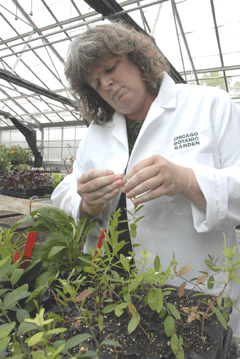
Dr. Kay Havens of the Chicago Botanic Garden. Havens leads a team of over 200 scientists, research associates, graduate and undergraduate students who are making vital discoveries about plant survival, habitat destruction, invasive species and restoration. (Photo: Courtesy of Chicago Botanic Garden)
CURWOOD: You may be more than ready for this winter to end, and while you look for signs of spring, you might want to lend science a hand. What you do is join Project Budburst, linked to the University Corporation for Atmospheric Research. Their website will allow you to log on and document the emergence of flowers and foliage to track climate change. Among the creators of the website is Dr. Kay Havens, director of plant science and conservation at the Chicago Botanic Garden. She joins us now from her office in Glencoe, IL.
Welcome to Living on Earth, Dr. Havens.
HAVENS: Thank you very much.
CURWOOD: So what can blooming flowers tell us about climate change?

Mertensia virginica (Virginia bluebells). Kay Havens recorded the date the bluebells flowered in her own garden. (Courtesy of Chicago Botanic Garden)
CURWOOD: So, what prompted you to come up with this website - Project BudBurst - where just about anyone can log in and document when the flowers bloom in their yard or anywhere they care to look I would gather.

A Trout Lily. (Courtesy of Chicago Botanic Garden)
CURWOOD: And an opportunity to become a phenologist, right?
HAVENS: That’s correct!
CURWOOD: So, how does this website work - I mean how could one of our listeners get involved in this?
HAVENS: You can sign in and become a BudBurst member and record your location. And after that you can look at species guides, decide which species you want to monitor, watch them in your own yard and then log in and tell us the day that they first come into bloom, or you see the first leaf or you see the first fruit.
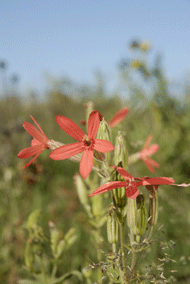
Silene regia (Royal catchfly). Project BudBurst hopes to gather data on flowers like the Royal Catchfly. (Courtesy of Chicago Botanic Garden)
HAVENS: Well, we at the Garden and a number of other scientists are modeling how plants will respond to climate change. So we want to know: what climate envelopes do plant species survive in, as the climate changes where might they need to migrate to? And so getting data on bloom time is very valuable to use in these modeling efforts.
CURWOOD: Now, to what extent do you have schools involved in this?
HAVENS: We have a lot of school groups who participate. In our pilot year we had over 900 observations submitted and of those, nearly two thirds were done by children under 12.
CURWOOD: So this is not just citizen science, this is kid science!
HAVENS: This is kid science! Yeah, and we’re thrilled to be really engaging kids in collecting data that is important and useful.
CURWOOD: Now I imagine you’re too busy at this Chicago Botanic Garden to have your own garden.
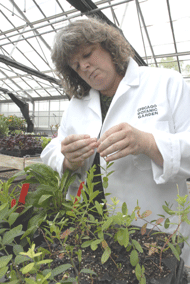
Dr. Kay Havens of the Chicago Botanic Garden. Havens leads a team of over 200 scientists, research associates, graduate and undergraduate students who are making vital discoveries about plant survival, habitat destruction, invasive species and restoration. (Courtesy of Chicago Botanic Garden)
CURWOOD: [LAUGHS] So what’s your favorite flower or vegetable for that matter that you grow in your garden and how has its blooming pattern changed over the years?
HAVENS: Oh gosh, that’s a tough one. I did submit data on Dogtooth Violet and Bluebells last year - out of my own garden - two of my favorite little native spring wildflowers. And I have noticed over the years the springs are coming earlier and getting warmer and those plants are blooming earlier.
CURWOOD: Dr. Kay Havens is the director of plant science and conservation at the Chicago Botanic Garden. Which helps run the website Project BudBurst.
Thank you so much Dr. Havens.
HAVENS: Thank you and enjoy spring!
CURWOOD: I will a little bit sooner then I would have last year.
HAVENS: Yeah. [LAUGHS]
CURWOOD: And you can find a link to Project BudBurst through the Living on Earth website www.loe.org.
Related links:
- Project BudBurst
- Chicago Botanic Garden
[MUSIC: The Skatalites “Flowers For Albert” from Hi-Bop Ska (Shanachie Records 2000)]
CURWOOD: Coming up: Unlocking the dirty secrets of the deep – thanks to whales. Keep listening to Living on Earth
ANNOUNCER: Support for the environmental health desk at Living on Earth comes from the Cedar Tree Foundation. Support also comes from the Richard and Rhoda Goldman Fund for coverage of population and the environment. This is Living on Earth on PRI: Public Radio International.
[MUSIC: Herbie Hancock: Joanna’s Theme from The Essential Herbie Hancock (Legacy Records 2006)]
Bad News from the Blubber
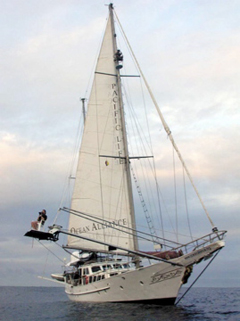
(Photo: Ocean Alliance)
CURWOOD: It’s Living on Earth. I’m Steve Curwood. Gloucester Harbor—north of Boston—is perhaps best known as a fishing port. It’s also where the 93-foot ketch “Odyssey” is docked. The Odyssey is a unique research vessel. It’s designed to study the behavior and biology of the world’s largest and longest-lived mammals: whales.

Tail of a humpback whale in Alaska. Humpback whales are best known as extraordinary vocalists. Their songs evolve over time and can be heard across oceans. (Photo: Ocean Alliance/Iain Kerr)
[MAN SAYS “AHOY”; MAN SHOUTS; MAN SAYS “…BRING HER IN WHEN YOU’RE READY…” MAN ANSWERS “ALRIGHT”]
GELLERMAN: It was a cold, blustery day, but the seas were calm as I stepped on the deck of the research vessel Odyssey. Captain Iain Kerr lent a hand.
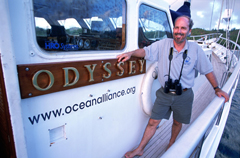
Iain Kerr is Captain of the research vessel Odyssey. (Photo: Ocean Alliance/Chris Johnson)
KERR: Doing good, doing good. You?
GELLERMAN: Fine, thank you.
KERR: It’s not the best of days.
GELLERMAN: Oh, it’s a bit nippy.
KERR: Wee bit nippy.
GELLERMAN: Iain Kerr was born in Scotland and is CEO of the Ocean Alliance. The Odyssey is owned and operated by the non-profit, which was founded by Dr. Roger Payne.
GELLERMAN: Hello, Dr. Payne. How are you?
PAYNE: Very well. Roger is my name by the way.
GELLERMAN: Roger Payne is perhaps best known for his discovery that humpback whales sing songs. Ten and a half million copies of the recording were distributed by National Geographic magazine. It’s still the largest single pressing in the history of the music industry. Roger Payne and Iain Kerr are shipmates from way back.

Dr. Roger Payne has been studying whale acoustics for 40 years. Five and a half years ago he began a round-the-world study to collect baseline data on pollution levels in whales. (Photo: Ocean Alliance/Chris Johnson)
PAYNE: I feel that this effort to figure out how badly polluted the oceans of the world are is in fact the most important thing I’ve ever been involved with scientifically.
GELLERMAN: Why did you get interested in whales?
PAYNE: Well, I started working on sounds of bats, then went to owls, then went to moths, which are all animals for which acoustics are really very important and then I began to think ‘well I’m just entertaining myself. I’m not doing anything that responds to their problems. I could see that we’re taking the world down the drain, basically.’ And then I thought, well if the only thing you know about is the acoustics of animals, what could you do that would matter and then I thought ‘ahh, whales.’
[MUSIC: Roger Payne “Tower Whales” from ‘Songs of the Humpback Whale’ (Living Music 1991)]
PAYNE: That would be it because I knew enough to know they were—had very important acoustic lives.
[WHALE SONG]
PAYNE: But I had never seen a whale. I didn’t know anything about them and the moment I had that idea I realized, okay, I’ll spend the rest of my life doing that.
[WHALE SONG]
GELLERMAN: What do you mean an ‘acoustic animal?’
KERR: Well, I think Roger should talk more to this, but we live in a world of sight. You know, we look around us. Whales live in a world of sound. Often the oceans are dirty, you can’t see more than ten feet. Yet Roger demonstrated that whales could hear sound across oceans. So you need to understand they live in a whole different world to us.
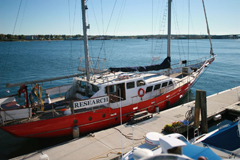
The Odyssey is a 93 foot long steel hulled ketch. (Photo: Ocean Alliance/Iain Kerr)
KERR: But one of the key components of this boat—and it goes back to Roger’s history with the bioacoustics of whales—is we have an acoustic array. A 1,000-foot cable that goes behind the boat. It’s about 100 feet down, and as we’re under way there’s a screen here in front of the helm. You can actually see images of sounds that are being made in the background. And that enables us to track whales 24 hours a day. And it’s really changed the way that we interact with whales and attract whales.
[WHALE SONG]
KERR: And what’s great about this boat is it’s a real tough deep-water boat. It’s got a great, extended offshore capability. Because while we know a lot about the pollution in the Hudson River or the St. Lawrence Seaway, what’s happening in the middle of nowhere. So the whole idea is we needed a boat that would be comfortable for the crew—you know on the old British expeditions you know, you had to have a couple of people die for it to be a successful expedition. We’ve evolved slightly from that now, and the truth is you’re more productive. If people can be comfortable, you can be more productive.
GELLERMAN: You had this five-year expedition. How many whales did you track during that time?
KERR: Well you know, boy, I don’t think I even have an answer for that but I would think thousands. I mean, you need to understand, as we’re going along, we’re recording whales that we interact with every 30 minutes often and the boat ran 24 hours a day. So that’s one of the challenging components about this voyage, is the masses of amount of data we’ve got, and what’s interesting about the data is not necessarily that we’ve been to places that no one’s been before, but we’ve been with a type of technologies, with a type of expertise and skill sets that haven’t been to some of these remotest places on the planet.
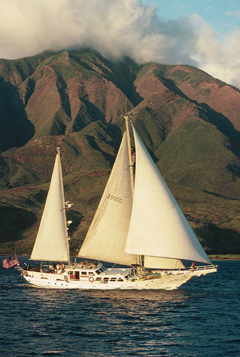
The research vessel Odyssey sailing the coast of Hawaii. (Photo: Ocean Alliance/Iain Kerr)
KERR: To get the physical sample from the whale, we like to do a little biopsy So here we just have a quite a simple crossbow—it only cost us like $100, okay, but it does fire a very expensive dart that’s actually made in Finland, and it’s got a little rubber head on it, and when it hits the whale, it bounces and pulls out a very small biopsy about the size of razor head on a pencil.
GELLERMAN: How does it physically work? You pull the string back…
KERR: Well we cock the string back, slide the arrow in—so you have to find a patch of skin. There’s a nice adult spoon whale that is bringing its toxic load down from Antarctica. And you take the biopsy, and the arrow bounces off and then the boat motors up and there’s a person on the bow that scoops the arrow out of the water.
GELLERMAN: Does it hurt the whale?
KERR: Well I don’t think so. You know, the skin of these whales is really tough. I mean, these animals are going down a mile deep. They have really tough skin. I mean, I think one of these arrows—occasionally we fire them and they bounce off. It’s incredible. Had it hit your eye it would have been stuck in three inches. Do you want me to show you?
GELLERMAN: (laughs) No. Thank you, no.
KERR: Okay, so let’s head up onto the bow now, and I’ll show you where we stand when we’re underway and where the biopsy person works from.
[SOUND OF BEING ON BOAT DECK, WALKING TO BOW]
KERR: It will give you a better perspective. You can see these doors are very seaworthy—very heavy. So we’re standing up on the bow now and there’s a pole that sticks out from here 35 feet that we call the whale boom. And what we found was—and just think about it in human nature. If I come up behind you—you know, in the street in the evening, you might be a little nervous. If I’m walking beside you, you know you feel more comfortable—I’m in your periphery. So we found with the whales, rather than coming up behind them, we’d come up alongside of them and then we could be 100 feet from the whale because the boom sticks out 30 feet and then when we took the biopsy, you know—
GELLERMAN: Now this boat is 90 some-odd feet long.
KERR: That’s correct.
GELLERMAN: Whale’s going to be 50-60 feet.
KERR: We’ve been next to blue whales in the Galapagos that was big as the boat. It’s certainly—you understand your place in the wild world when you study whales. You know, we all think it’s all about humanity and yet you get out in the ocean with some of these whales—eyes the size of a grapefruit, little wrinkles, and they’re looking at you saying ‘you know, you’re an intelligent species—look at my lifestyle.

Face to face with a southern right whale in Argentina (Photo: Ocean Alliance/Iain Kerr)
KERR: Yeah.
GELLERMAN: When somebody’s way up on top, do they say, and they see a whale, do they say ‘Thar she blows?’
KERR: They tend to do. You do get caught up in the mystique of the moment. The other favorite one is of course, ‘Land ahoy!’ When you’ve been at sea 36 days with nine people in a tin can, you know, listening to the same music, you know, sometimes you’re very ready to go ashore for some R&R.
[SOUND OF OBJECTS BEING SHUFFLED AROUND]
KERR: So on the wall here, we just have the general screen to show people that when we collect a biopsy we cut it up in from five to seven different parts. So here was our sort of workstation. Obviously we’re at dock right now so we don’t have all the scientific tools lying out.
GELLERMAN: This is your laboratory?
KERR: Well, it is our laboratory. We’re building a larger laboratory back aft in the boat but as soon as you get the samples you want to process them as quickly as you can. So if you think about it, the ocean is what—seven feet from where we are right now. So we collect the biopsy and within seconds sometimes, worst case minutes, we’re processing the samples. And Roger will talk to you more about what we do with each of those components.
PAYNE: We’ve looked at a bunch of samples, but we haven’t looked at all the samples. That remains to be done if we can ever raise the funds necessary to do that. But what we can say is that these animals are polluted beyond your wildest dreams. They are appallingly polluted.
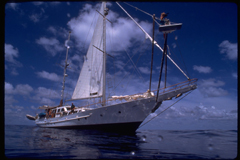
The Odyssey ran 24 hours a day collecting audio recordings and blubber samples from thousands of whales. (Photo: Ocean Alliance/Chris Johnson)
GELLERMAN: Polluted with what?
PAYNE: All sorts of things, including synthetic molecules that human beings make of a huge variety—hundreds of different things. The ocean is downhill of everything on earth, and the result is that everything flows into the ocean from higher ground, and that means it’s the ultimate cesspool basically of the world. Industry has always said, ‘The solution to pollution is dilution’ and it’s absolutely true—if you take some poison and drop it somehow into the ocean or it eventually gets there in streams, it gets diluted down to such low concentrations that in fact, it is harmless. But then a totally insidious thing happens and that is—it dissolves into the oil droplets that are part of the—well they are the base of the food chain and so anything we produce that animals can’t handle they then can’t get rid of and the result is they have to store it and they pass it up foodchains.
KERR: We should talk about too—and maybe if I start this, Roger, and if I do it badly you’ll take it over—we collect this biopsy and we cut it up into pieces, and we get the skin for the genetics, for is it Ian, is it Roger, okay. You’ve then got the blubber, which has got fatty acids in it, which tell us where does it feed on the food chain. You’ve then got the stable isotopes, which tell us roughly where it actually picked up the food that it’s got. And then finally, we’ve got the blubber that we use for the hard contaminant load, and then the skin that we grow the cell lines for, so this tiny little piece of blubber really demonstrates one, that you don’t need to kill whales to learn about them, and two, provides us with, you know, an incredible amount of information about where the animal fed, where it lived, where it fed on the food chain, is it male, is it female.
GELLERMAN: What things are in the ocean, or showing up in these animals, that are causing such problems?
PAYNE: We’re concerned about things like fire retardants. We haven’t done any analysis of those. We don’t know where they stand yet, but hopefully we’ll soon know the answer to that, and we’re interested in the other kinds of things that everybody knows is out in the oceans- things like mercury and other metals and persistent organic pollutants, which is a category so large as to be almost useless, but nevertheless a whole series of molecules which we’re looking at a few of.

(Photo: Ocean Alliance/Chris Johnson)
PAYNE: Many of the substances that we’re concerned with are fantastically insoluble in water. They are highly soluble in fat. So what happens is that they end up in the ocean water, anywhere in parts per trillion or parts per quadrillion, so hugely diluted. But as soon as they get into fats they end up in very, very high concentrations because the fats can hold lots of them. The trouble is the animals don’t have any way of dealing with them so they store them, and then they get passed on when that animal gets eaten by some other animal. So here on your plate is a pound of swordfish. It took a million pounds of diatoms to create that one pound—not the whole fish—just that one pound. A million pounds is 500 tons, so it took 50, ten-ton truckloads of diatoms to make that one pound of swordfish. So you take all those trucks and you park them along a row, it’s about ten blocks long, and to the end of that row you attach your liver and with it you detoxify that entire line of trucks. And that’s what you do when you eat a pound of swordfish. And then maybe tomorrow you have another pound. I adore swordfish. I would do anything to have a piece of swordfish except eat it.
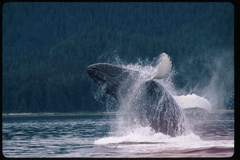
A humpback whale breeches in Argentina.(Photo: Ocean Alliance/Iain Kerr)
PAYNE: And an animal like whales—this is going to get worse and worse and worse from generation to generation, because these substances last so long—so much longer than the lifetimes of these animals, and the result is—I assume—is extinction.
GELLERMAN: What happens now? Where do you go from here?
PAYNE: We are desperately trying to raise the funds necessary to complete the analysis of these compounds. It’s—in the scheme of things—it’s so little money—I mean, it’s less than a million dollars that we need. Once we have the funding necessary to complete the analysis of the samples that we’ve got, we will be able to say, ‘this is how polluted the oceans of the world are with these substances. And the question of why does that matter would be—the answer is very simple. Humanity is about to lose access to fish from the sea, because the fish from the sea are becoming too polluted to be eaten safely.
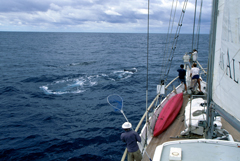
The Odyssey often comes to within 100 feet of a whale to take a sample of blubber.(Photo: Ocean Alliance/Chris Johnson)
GELLERMAN: I would think that you believe this is the most compelling, important issue of our time, and I’m wondering why it’s so hard to raise money around research like this.
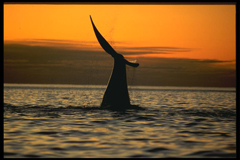
Tail of a right whale at sunset in Argentina.(Photo: Ocean Alliance/Iain Kerr)
GELLERMAN: So this is not an us-against-them problem.
PAYNE: Oh, absolutely not. And those who make it an us-against-them problem ensure that it is an unsolvable problem.
[WHALE SONG]
CURWOOD: Living on Earth’s Bruce Gellerman and producer Bobby Bascomb visited the Odyssey in Gloucester Harbor. Ian Kerr and Roger Payne of the Ocean Alliance use it to study whales around the world. There’s a link to their website at ours: L-O-E dot O-R-G. And these are humpback whales, recorded by Roger Payne.
[WHALE SONG]
Related link:
Ocean Alliance
CURWOOD: On the next Living on Earth, laughing their way across the desert.
THAYER: We sing songs together. You wouldn’t want to hear us - it’s just as well we go out there to sing, ‘cause no one would want us to sing, we’re just awful – or sometimes Bill will start to tell jokes – we might have heard them 20 times already but they’re still funny out there – and then sometimes we see the funny side of what we’re doing and laugh at ourselves.
CURWOOD: You’re never too old to walk the Gobi. That’s next time on Living on Earth.
[MUSIC: Roger Payne “Tower Whales” from ‘Songs of the Humpback Whale’ (Living Music 1991)]
CURWOOD: We leave you this week in the company of right whales, snoring. Recorded by Roger Payne.
[EARTHEAR: Roger Payne “Surrounded By Snoring” from ‘Deep Voices: Recordings of Humpback, Blue and Right Whales’ (Living Music 1995)]
CURWOOD: Living on Earth is produced by the World Media Foundation. Our crew includes Ashley Ahearn, Bobby Bascomb, Eileen Bolinsky, Bruce Gellerman, Ingrid Lobet, Helen Palmer, Emily Taylor, and Jeff Young, with help from Jennifer Baessler, Sarah Calkins and Mitra Taj. Our interns are Annie Jia and Margaret Rossano.
Jeff Turton is our technical director. Alison Lirish Dean composted our themes. You can find us anytime at L-O-E dot org. I’m Steve Curwood. Thanks for listening.
ANNOUNCER: Funding for Living on Earth comes from the National Science Foundation, supporting coverage of emerging science; Stonyfield Farm, organic yogurt and smoothies. Stonyfield Farm pays its farmers not to use organic growth hormones on their cows. Details at Stonyfield.com. Support also comes from you our listeners, the Ford Foundation, the Town Creek Foundation, the Oak Foundation, supporting coverage of climate change and marine issues, and Pax World Mutual Funds, socially and environmentally sustainable investing. Pax World: for tomorrow. On the web at paxworld.com.
ANNOUNCER: PRI: Public Radio International.
Living on Earth wants to hear from you!
Living on Earth
62 Calef Highway, Suite 212
Lee, NH 03861
Telephone: 617-287-4121
E-mail: comments@loe.org
Newsletter [Click here]
Donate to Living on Earth!
Living on Earth is an independent media program and relies entirely on contributions from listeners and institutions supporting public service. Please donate now to preserve an independent environmental voice.
NewsletterLiving on Earth offers a weekly delivery of the show's rundown to your mailbox. Sign up for our newsletter today!
 Sailors For The Sea: Be the change you want to sea.
Sailors For The Sea: Be the change you want to sea.
 The Grantham Foundation for the Protection of the Environment: Committed to protecting and improving the health of the global environment.
The Grantham Foundation for the Protection of the Environment: Committed to protecting and improving the health of the global environment.
 Contribute to Living on Earth and receive, as our gift to you, an archival print of one of Mark Seth Lender's extraordinary wildlife photographs. Follow the link to see Mark's current collection of photographs.
Contribute to Living on Earth and receive, as our gift to you, an archival print of one of Mark Seth Lender's extraordinary wildlife photographs. Follow the link to see Mark's current collection of photographs.
 Buy a signed copy of Mark Seth Lender's book Smeagull the Seagull & support Living on Earth
Buy a signed copy of Mark Seth Lender's book Smeagull the Seagull & support Living on Earth

